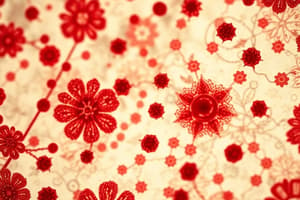Podcast
Questions and Answers
What does magnification indicate?
What does magnification indicate?
- The ratio of the size of the image to the actual size of the specimen (correct)
- The number of times the image is smaller than the specimen
- The distance between the observer and the specimen
- The actual size of the specimen in millimeters
If an object measures 50 μm in actual size and is magnified to 200 mm, what is the magnification factor?
If an object measures 50 μm in actual size and is magnified to 200 mm, what is the magnification factor?
- $5000$
- $4000$ (correct)
- $2500$
- $2000$
What is essential when performing calculations for magnification?
What is essential when performing calculations for magnification?
- Using the same unit for image size and actual size (correct)
- Calculating magnification in a specific order
- Using only metric measurements
- Converting all sizes to centimeters for ease
Which of the following provides a correct example of a measurement unit for cells?
Which of the following provides a correct example of a measurement unit for cells?
If an image has a magnification of 1500 and the actual size of the specimen is 0.02 mm, what is the size of the image?
If an image has a magnification of 1500 and the actual size of the specimen is 0.02 mm, what is the size of the image?
What is the total magnification of the specimen when using both the eyepiece and objective lenses?
What is the total magnification of the specimen when using both the eyepiece and objective lenses?
How do you convert the image size from millimetres to micrometres?
How do you convert the image size from millimetres to micrometres?
What is the average size of a red blood cell in this sample?
What is the average size of a red blood cell in this sample?
If the eyepiece lens magnification were to change to x20, what would the total magnification become?
If the eyepiece lens magnification were to change to x20, what would the total magnification become?
What is an essential requirement for specimens viewed under a light microscope?
What is an essential requirement for specimens viewed under a light microscope?
Why is staining important in slide preparation?
Why is staining important in slide preparation?
Which calculation is necessary to find the actual size of the red blood cell from the image size?
Which calculation is necessary to find the actual size of the red blood cell from the image size?
What is the first step in preparing a slide that requires staining?
What is the first step in preparing a slide that requires staining?
What occurs after air-drying a sample for slide preparation?
What occurs after air-drying a sample for slide preparation?
What is the primary function of an eyepiece graticule?
What is the primary function of an eyepiece graticule?
How is an eyepiece graticule calibrated?
How is an eyepiece graticule calibrated?
Which factor does NOT influence the choice of staining method used for specimens?
Which factor does NOT influence the choice of staining method used for specimens?
What is a common characteristic of cellular materials that often require staining for observation?
What is a common characteristic of cellular materials that often require staining for observation?
What is the value of one graticule division when calibrated using a stage micrometer that has 100 µm divided into 40 divisions?
What is the value of one graticule division when calibrated using a stage micrometer that has 100 µm divided into 40 divisions?
Which of the following is NOT a step in preparing a stained slide?
Which of the following is NOT a step in preparing a stained slide?
What happens to the calibration of the eyepiece graticule when the magnification of the microscope changes?
What happens to the calibration of the eyepiece graticule when the magnification of the microscope changes?
How does the type of cellular material affect slide preparation?
How does the type of cellular material affect slide preparation?
If an object measures 10 graticule divisions, what is the measured length in micrometres when the magnification factor is 2.5 µm?
If an object measures 10 graticule divisions, what is the measured length in micrometres when the magnification factor is 2.5 µm?
What is contained within an eyepiece graticule?
What is contained within an eyepiece graticule?
Why is it necessary to use a stage micrometer alongside an eyepiece graticule?
Why is it necessary to use a stage micrometer alongside an eyepiece graticule?
What measurement system is primarily used with the eyepiece graticule?
What measurement system is primarily used with the eyepiece graticule?
What is the primary advantage of using an electron microscope over a light microscope?
What is the primary advantage of using an electron microscope over a light microscope?
Which of the following statements is true regarding light microscopes?
Which of the following statements is true regarding light microscopes?
What type of microscope would be best suited for examining viruses?
What type of microscope would be best suited for examining viruses?
What is a limitation of using electron microscopy?
What is a limitation of using electron microscopy?
How do electron microscopes enhance the resolution in imaging compared to light microscopes?
How do electron microscopes enhance the resolution in imaging compared to light microscopes?
What size range of specimens can be effectively examined with light microscopes?
What size range of specimens can be effectively examined with light microscopes?
In electron microscopy, what type of microscopy allows for three-dimensional imaging?
In electron microscopy, what type of microscopy allows for three-dimensional imaging?
Which of the following is NOT a use of electron microscopy?
Which of the following is NOT a use of electron microscopy?
Flashcards are hidden until you start studying
Study Notes
The Microscope in Cell Studies
- Microscope slide preparation is essential for detailed observation of cellular material.
- Specimens must be thin enough for light to pass through effectively.
- Preparation methods vary depending on the type of cellular material being observed.
- Staining may be required as many cellular structures are transparent, utilizing stains appropriate for specific specimens.
Magnification Calculations
- Magnification (M) indicates how many times larger the image is compared to the actual specimen size.
- Magnification can be calculated using the formula: M = I / A, where I is image size and A is actual size.
- Measurements must be in consistent units—micrometers (μm) and nanometers (nm) are standard.
Eyepiece Graticules & Stage Micrometers
- Eyepiece graticules and stage micrometers are tools used for measuring objects under a microscope.
- Calibration of the eyepiece graticule is necessary for each magnification setup, using a stage micrometer with a known scale.
- Eyepiece graticule features 100 divisions, requiring calibration to relate graticule divisions to micrometers.
- The formula for calculating actual size based on graticule divisions is: measurement (µm) = graticule divisions x magnification factor.
Comparison of Light and Electron Microscopes
- Light Microscopes: Effective for specimens larger than 200 nm; utilize light for imaging, suitable for observing live or dead specimens, and ideal for viewing whole cells and small organisms.
- Electron Microscopes: Used for specimens larger than 0.5 nm; provide higher resolution due to electron beams instead of light. They are limited to dead specimens and are excellent for studying organelles, viruses, and DNA in detail.
Example Calculation: Size of Red Blood Cells
- Given an image size of 3 mm with eyepiece magnification of x10 and objective magnification of x40:
- Total magnification = 10 x 40 = x400.
- Convert image size to micrometers: 3 mm = 3000 μm.
- Actual size of red blood cell is calculated as: 3000 μm / 400 = 7.5 μm.
Studying That Suits You
Use AI to generate personalized quizzes and flashcards to suit your learning preferences.



